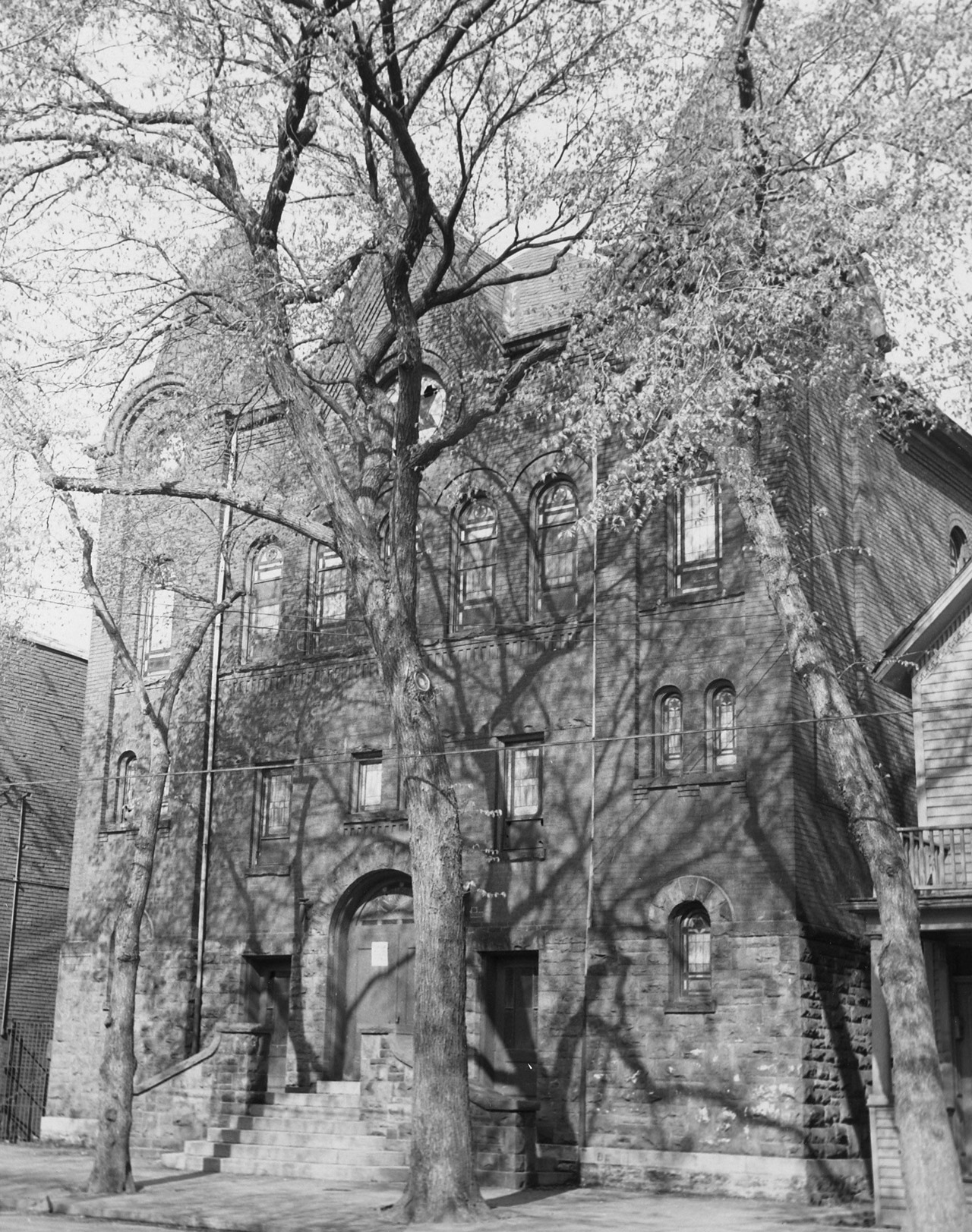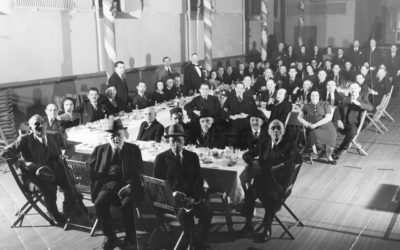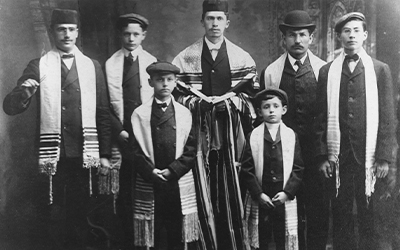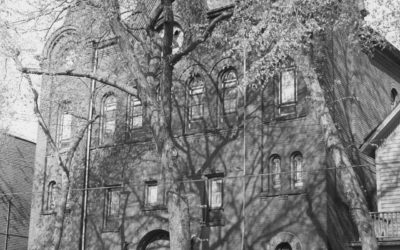Synagogues / Brith Sholem
Brith Sholem was founded as an orthodox congregation in 1865 from an existing mutual benefit society. After reincorporation in 1892, the congregation moved to Pine Street in 1893. Despite a move to North Buffalo in 1951, Brith Sholem was still known as the Pine Street Shul.
Overview
Founded in 1865, Congregation Brith Sholem grew out of a mutual benefit society led by a group of landsmann from Volkovisk, Lithuania that met at the store of Harris Greenberg every shabbat. The landsleit group was formerly incorporated under the name of Chevra (Hebrew: Society) Brith Sholem in 1866 to help sick and bereaved Jewish families. Members included the Grodzinsky, Bernstein, Lewis, Aaron, Mendelsohn, Weber, Alpern, and Cohen families, according to research undertaken by Selig Adler and Thomas E. Connelly, published in From Ararat to Suburbia: The History of the Jewish Community of Buffalo.
Shabbat services moved to William Weber’s hoop skirt store on Main Street in 1870. A few years later the congregation converted a house at 169 Elm Street. Some original families continued their membership and new families joined. The active roster across the 1870s to1890s, included the Gumbinsky, Cohen, Garliner, Grodinsky, Kloneck, Einach, Saperston, Lichtenstein, Friedlander and Hyman families, and the interrelated families of Mayerberg and Rubenstein. The congregation established a cemetery in the rear part of (Old) Beth Zion cemetery on Pine Ridge in 1875. In 1881, however, the congregation split over internal divisions, and a sub-section left to establish a new congregation: Beth Jacob. In 1882, Brith Sholem, weaken numerically by the split, received an unexpected boost in membership that revived the congregation. In response to a wave of pogroms in Russia, larger numbers of East European Jews arrived in Buffalo, and the traditionalism of Brith Sholem appealed to these newcomers over the other congregational alternatives. It was during this period from 1890 to 1914, that Rabbi Simon Paltrovich joined the congregation as its religious leader.
The Elm Street location was outgrown within two decades so a new site was selected at 171, Pine Street in 1893. Located between William and Clinton, it was Pine Street from where the congregation got its colloquial name. The Pine Street Shul at the turn of the twentieth century was also known for its Hazzan, Cantor Samuel Arluck. His son, Hyman Arluck was born in 1905 and by the age of 7, he was singing in the Pine Street (B’rith Sholem) synagogue choir. Hyman began taking piano lessons at the age of 9, studying with Arnold Cornelisson, conductor of the Buffalo String Orchestral Society. After dropping out of school, he began the Snappy Trio, as singer, pianist and arranger. He later formed the Buffalodians. In 1926, Hyman changed his name to Harold Arlen by combining his mother’s (Celia Orlin) and father’s last names. Leaving Buffalo for New York City, he collaborated with Ted Koehler and their songs were performed at the Cotton Club. He wrote numerous shows including, You Said it, with fellow Buffalonian, Jack Yellen. Following the impact of the Depression on Broadway, Arlen relocated to California, and in 1938 with Yip Harburg was hired to create the music for The Wizard of Oz, staring Judy Garland. Other hits included Frank Sinatra, Last Night When We Were Young, and Barbara Streisand’s duet with Judy Garland, Happy Days/Get Happy in 1963, as well as Ethel Walter’s, Stormy Weather.
Replacing Cantor Arluck, Brith Sholem welcomed Joshua H. Singer from rival congregation Beth Jacob. Singer ran a religious book store on William Street that was subsequently expanded to sell Judaica by Reverend Isaac Manch. Active Brith Sholom families from 1920 included Joseph Saperston, Rabolinsky, Simonsky, Bookbinder, Freedman, Mendelsohn, Altman, Starsky, Goldstein and Yellens. Nationally esteemed rabbis served the congregation from the 1920s, the first of whom was Rabbi Nissen Markel until 1945, followed by Talmudic authority, Rabbi Berciz Zuckerman who led the congregation for the next quarter century, and through its move to Hertel Avenue in 1951. Two years later in 1953, Rabbi Zuckerman along with Rabbi Justin Hofmann and Rabbi Samuel and Miriam Stern began the groundwork for the Kenmore Mikvah, that opened in 1957 at 1248 Kenmore Ave. During the 1950s, a small group of former Holocaust survivors joined Brith Sholem, and they and other survivors as well as community members funded the creation of a Holocaust memorial at Pine Ridge in Old Brith Sholem cemetery.
Gallery
Pine Street Shul meeting, with Louis Bookbinder and Louis Freedman, c.1930. Photographer Unknown, Courtesy of Nancy Freedman Schiller.
Pine Street Shul with Louis Bookbinder
Cantor Samuel Arluck (holding siddur), and son Hyman Arluck (smallest boy, later known as Harold Arlen), c.1912. Collection of Hubert J. Rubenstein, 1853-2006. Courtesy of the University Archives, University at Buffalo, The State University of New York. Cantor Samuel Arluck is holding the siddur book in the center of this image. His son, Hyman Arluck, is the smallest boy in the front row, c.1912. The Pine Street Shul also known as B’rith Sholem, was originally founded in 1865, and located first on Main Street and then on Elm Street. It reincorporated in 1882 at Pine Street.
Cantor Samuel Arluck and Son
Brith Sholem, “Pine Street Shul,” 1959. Photographer unknown, Box 7.12, Ms150.5, “Synagogue Records, 1884-1986” University Archives, University at Buffalo, The State University of New York.
Brith Sholem, “Pine Street Shul,” 1959
Discover More
- Selig Adler and Thomas E. Connelly. From Ararat to Suburbia: The History of the Jewish Community of Buffalo. Philadelphia, Jewish Publication Society of America, 1960, p.103.
- Cemetery Listings on Find-A-Grave – Old Brith
- Cemetery Listings on Find-A-Grave – New Brith
- Rabbi Nissan Markel
- Rabbi Bericz Zukerman
- For more about the Kenmore Mikvah, within papers of its successor Buffalo Ritualarium, consult the Buffalo Ritualarium (Mikvah of Buffalo) Papers, 1998-2012 (MS200.23).
- Harold Arlen Connections official website includes other photographs from childhood in Buffalo
- To see Harold Arlen playing his own music: Jacqueline Bassan, From Shul To Cool: The Romantic Jewish Roots Of American Popular Music, 2003;
- Judy Garland singing Harold Arlen
- This comprehensive biography also traces his Buffalo roots: Jablonski, Edward, Harold Arlen: Rhythm, Rainbows, and Blues. University Press of New England, 1996.
Collections
- “Dr. Hubert J. Rubenstein, 1853-2006,“ Box 1.2, Ms96, University Archives, University at Buffalo, The State University of New York.
- The photograph of Hyman Arluck was derived from the “Dr. Hubert J. Rubenstein, 1853-2006,” collection. Pictured in this photograph is also Dr. Rubenstein’s grandfather at aged 16 on the far right. A descendant, Lewis Rubenstein, from the same Rubenstein family, was the painter of the mural located at the Jewish Community Center, Delaware Avenue.
- Materials for Brith Sholem, also known as the Pine Street Shul, are housed in the University Archives, University at Buffalo, NY, as part of materials originally collected by Professor Selig Adler in the 1980s, some of which is in Hebrew and Yiddish. Documents include materials about the cemeteries and meeting records, account books dating from 1884, small receipt books and memorandum pads and information regarding Displaced Persons and Holocaust survivors. To learn more consult the records at the University Archives at the University at Buffalo. Click on the blue link to read the online listing of Ms150.5 “Synagogue Records, 1884-1986”.
Contribute to this Page
We are seeking internal and external photographs, documents, film, mementos and written recollections relating to Brith Sholem sometimes known as the Pine Street Shul for digitization. If you have materials you’d like to make available for this purpose, please contact us.




